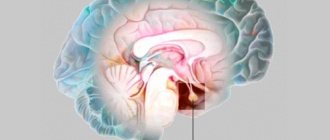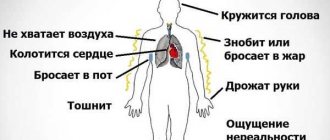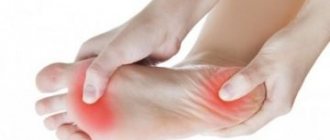General information
Orthopedic foot pathology in an industrial society tends to increase, as evidenced by the frequency of patient visits.
This is due to the sharply increased load on the foot, which is a complex anatomical formation, including 26 bones, 33 joints, 19 muscles, 107 ligaments and the neurovascular system, combined with the ankle joint into a single system, which allows effectively providing locomotor, spring and balancing functions in the process of walking, running and jumping. One of the common causes of foot dysfunction is Morton's disease (synonyms: Morton's neuroma, Morton's metatarsalgia, Morton's syndrome, interdigital neuroma, perineural fibrosis, foot neuroma, Morton's toe syndrome). Interdigital neuroma is a local limited thickening (formation) of the plantar nerve sheath of an elongated, fusiform shape at the level of the passage of the nerve between the heads of the metatarsal bones. The average size of a neuroma is 0.95–1.40 cm in length and 0.15–0.55 cm in width. It is believed that the disease manifests itself with local thickening of the nerve from 5 mm in diameter. In fact, Morton's neuroma is one of the manifestations of tunnel syndrome on the foot, that is, it is a tunnel (compression) neuropathy of the interdigital nerve of the foot.
Tunnel syndromes , which are characterized by compression with developing microcirculation disorders in peripheral nerves located in the so-called “tunnels” - anatomically narrow fibrous/fibro-osseous canals, are a fairly common form of damage to the peripheral nervous system.
The trigger point for the development of the disease is multiple repeated microtraumas and nerve compression. There are no exact data on the epidemiology of the disease, but it has been established that it is relatively rare and women aged 35 to 60 years are much more likely to suffer. Morton's neuroma on both feet at the same time is rare; it is usually a unilateral nerve lesion. Complaints about severe pain and sensitivity disorders lead to loss of ability to work and a decrease in quality of life, and since patients are predominantly people of active working age, the significance of this problem is also of social importance.
Prevention
Measures to prevent the development of inflammation of the plantar nerve are quite simple, and their observance does not require much effort from the person.
If possible:
- wear comfortable shoes;
- avoid frequent work in a standing position;
- engage in the prevention of the development of flat feet, especially in childhood;
- for women whose clothing style requires them to wear heels, daily foot massage and relaxing baths are recommended;
- carry out regular foot massage, which is also necessary for other categories of people;
- fight excess weight, which increases the load on the feet.
Following these recommendations will help you prevent the development of neuroma of the foot and other diseases of the extremities. When using non-standard methods of prevention, you must consult a specialist.
Prevention of foot neuroma is quite simple and does not require much effort. First of all, it is aimed at reducing pain and stress on the legs. It is worth remembering and adhering to certain rules:
- wear comfortable shoes;
- do not forget about the prevention of flat feet;
- after wearing heels, take relaxing foot baths;
- do not forget about foot massage;
- You need to monitor your weight, because if you are overweight, your legs will bear a lot of strain.
These tips are quite simple, and following them will not bring much difficulty.
It is important to remember that by neglecting the first manifestations of the disease, you may face more serious consequences, which will be much more difficult to get rid of.
Pathogenesis
The pathogenesis of Morton's disease is based on repeated/constant mechanical pressure of the intermetatarsal transverse ligament on the anastomosis of the medial/lateral plantar nerves (branches of the tibial nerve) in the second/third, rarely fourth intermetatarsal space (space). Compression of the transverse intermetatarsal ligament by mechanical means gradually injures the anastomosis of the plantar nerves, which initially leads to compression of the nerve trunks, and later to the reactive degeneration of nerve fibers with the gradual formation of Perriconcito spirals and growth flasks , as well as perineural proliferation of connective tissue. It is constant trauma that leads to the formation of inflammatory infiltrates and fusion of the epineural connective tissue with the adjacent bone/surrounding muscles.
Causes
Morton's disease is a polyetiological disease, in the formation of which both genetic predisposition and the influence of various exogenous/endogenous factors play an important role. Among the main etiological factors in the development of tunnel neuropathies are: increased load/overload of the forefoot, most often caused by constant wearing of shoes that are too tight or high heels, the use of shoes that cause transverse flat feet, foot deformities of various kinds, including flat feet , hematomas in the area where nerve fibers are localized, acute foot injuries (bruises, fractures, dislocations), gait with the foot turned inward, excess body weight, long walking, obliterating diseases of the blood vessels of the legs, autoimmune/infectious diseases, lipomas of various types on the foot, changes in the structure of the nerve and etc.
The risk group includes people whose professional activities involve long periods of walking, standing, lifting weights, as well as athletes involved in power sports, jumping, running, and patients with flat feet and various types of foot deformities. The presence of such a problem is also evidenced by the athletes' forum. Significant provoking factors are bursitis / tenosynovitis of the foot , obliterating endarteritis of the legs/ obliterating atherosclerosis , and the presence of a benign tumor (plexiform neuroma).
How to treat
There are two types of treatment for foot neuroma - conservative and surgical.
The first method is conservative. It aims to ease the work of the foot and reduce the load on the legs without using surgery.
This treatment method will help if the foot neuroma is in the initial stages, otherwise only surgical intervention can relieve the patient from pain and discomfort.
Conservative treatment of foot neuroma includes the following elements:
- wearing comfortable shoes, preferably with flat soles;
- use of orthopedic insoles;
- the use of special separators for the fingers so that they do not become deformed when walking;
- reducing stress on the legs, it is advisable to spend less time standing;
- give preference to orthopedic shoes;
- foot massage.
If these rules are followed, the pain should go away within 2-3 months, but if it intensifies, then painkillers are administered.
Also, medications such as:
- nimesulide;
- codelac;
- solpadeine;
- terpincode;
- diclofenac.
According to reviews, treatment of Morton's neuroma with such methods has its pros and cons. So the advantages of this technique include:
- absence of pain that occurs during surgery;
- lack of rehabilitation period;
- the ability to carry out treatment without disturbing the usual rhythm of life.
As for the disadvantages of this treatment, they are as follows:
- long period of treatment;
- is a more expensive treatment method;
- Due to the use of various drugs, the functioning of other organs may be disrupted.
Surgery
The second method of treating Morton's syndrome is surgery. This method is used in case of ineffectiveness of conservative treatment. There are several types of combating this disease through surgery, these are:
- Simple removal of neuroma. To do this, an incision is made between the third and fourth fingers, the neuroma is removed and removed, then stitches are applied, which can be removed after 2 weeks.
- Excision of the inflamed area of the foot. This method is considered the most radical and is used in exceptional cases. As a result of this operation, the finger becomes numb, and the patient no longer feels pain.
- Artificial bone fracture. This method is used in rare cases, since rehabilitation can take a whole month.
The benefits of surgery include:
- the ability to go home 2 hours after surgery;
- quite economical method of treatment;
- greater likelihood of eliminating the problem.
As for the minuses, these are:
- long-term rehabilitation;
- At first, you feel some discomfort when walking.
For neuroma, both conservative and surgical methods are used. The former contribute to the disappearance of pain, reducing the load on the leg, and restoring the functionality of the limb. Conservative methods are effective only in the early stages of pathology. In other cases, only surgical intervention can relieve the patient of discomfort.
Non-surgical treatment of neuroma involves:
- Wearing orthopedic shoes and special insoles that ensure uniform load on the foot. Wearing high heels and platform shoes is temporarily abandoned.
- Application of inter-finger separators. Such devices help keep the toes in the correct position, which prevents deformation of the joints when walking.
- Reducing stress on the legs. If you need to stay in a standing position for a long time, take breaks during which you sit or lie down. Patients who are overweight should engage in weight loss.
- Massage. Helps release a compressed nerve, restores nutrition and blood supply to tissues.
Following these rules will help you get rid of unpleasant symptoms within a few months. If the pain intensifies, traditional remedies are prescribed:
- Non-hormonal anti-inflammatory drugs (Diclofenac, Nimesil). The tablets relieve pain, swelling and other signs of nerve inflammation. Drugs in this group have a large number of side effects, so they are used in short courses.
- Local anti-inflammatory drugs (Voltaren, Diclovit). Active substances accumulate in the affected tissues without affecting the body. Creams, gels and ointments are applied to the skin 2-3 times a day.
- Chondroprotectors (Chondroxide, Chondroitin sulfate). Substances restore cartilage tissue, normalizing joint functions. Compressed nerve endings are released, which helps the pain disappear. Chondroprotectors are effective only with long-term use.
Surgeries are used when drug therapy is ineffective. There are several types of surgical interventions used for Morton's disease:
- Excision of neuroma. During the operation, a long incision is made in the area of the fourth finger, through which the affected nerve is removed. The thickened area is removed, after which the wound is stitched. The stitches are removed after 14 days.
- Removal of affected soft tissues of the foot. Such radical operations are used only in severe cases of pathology. After the intervention, the foot loses sensitivity and pain no longer occurs.
- Artificial bone fracture. The method is rarely used, because The operation has a long recovery period.
Surgical intervention has the following positive qualities:
- the ability to quickly eliminate pain;
- fairly low cost;
- almost 100% efficiency.
Negative aspects include a long recovery period and the appearance of unpleasant sensations when walking in the first weeks after the intervention.
ethnoscience
Folk remedies are auxiliary methods for eliminating neuroma. They reduce the intensity of unpleasant symptoms and prolong the period of remission.
The following remedies are most often used at home:
- Sagebrush. The leaves are ground until a homogeneous mass is formed. The resulting paste is applied to gauze, which is applied to the affected area overnight. This remedy is used whenever pain occurs.
- Pork fat. 100 g of raw materials are mixed with 1 tbsp. l. table salt. The resulting ointment is rubbed into the skin with massage movements. At night, wrap the foot in a warm cloth. Therapy lasts at least 3 months.
- Foot baths with herbal infusions. The procedures help relax muscles and restore blood circulation. Boil 100 g of chamomile, yarrow or sage in 1 liter of water for 20 minutes. The finished broth is poured into a basin with 5 liters of warm water. Feet are immersed in water for 15 minutes, after which socks are put on. Baths are taken daily, ending with a foot massage.
- Vinegar baths. For 1 liter of water, take 0.5 liters of 9% vinegar. The procedure lasts 15 minutes.
Symptoms of Morton's neuroma
The symptoms of a foot neuroma largely depend on its size: with a neuroma diameter of less than 5 mm, an asymptomatic course is more often observed. As the disease progresses, it begins to manifest itself initially as aching, shooting pain localized in the area of the 3rd-4th toe during or after physical activity. These symptoms of Morton's neuroma can be combined with paresthesia and other sensitivity disorders. Over time, the intensity/frequency of pain increases, and the time interval from the start of exercise to the onset of pain decreases.
Ultimately, the pain acquires a burning, acute character and appears at rest, while no changes in the configuration of the foot are observed. Sometimes patients develop the sensation of having a foreign object in their shoes. When palpating the foot (clinical test with compression in the frontal plane), the pain syndrome intensifies and irradiation appears in the fingers, which corresponds to the innervation of the affected nerve. With the progression of the pain syndrome, a parallel increase in sensory disorders (before anesthesia) is possible. Movement disorders are not uncharacteristic.
Treatment with folk remedies
The biggest misconception among patients is that treating Morton's neuroma with folk remedies can be effective, but in fact it only eliminates the symptoms, while the causes remain.
Because of this, Morton's neuroma can progress and lead to undesirable results.
This does not mean that this method is strictly prohibited; it can be used as an auxiliary to the main method of treatment.
For example, various bandages, herbal or flower compresses are used to relieve pain. Most often, lotions are made from wormwood.
To do this, the plant is ground, the resulting mass is placed on a bandage and applied to the foot overnight, and the pain gradually begins to go away.
It is advisable to use traditional methods only with the consent of a doctor, otherwise there is a risk of worsening your condition.
When brain cells die, a retrocerebellar cyst of the brain occurs - a dangerous formation that is fraught with serious consequences. Why is it so important to know the first signs of a brain tumor? Timely diagnosis and initiation of treatment increases the chance of success.
As a complement to drug therapy, and after operations, doctors recommend using traditional healers' remedies. But they warn that they provide only temporary relief from pain.
Healer Recipes:
- Wormwood lotions. Freshly picked leaves and soft stems of wormwood are ground into a mushy mass, applied to the site of severe pain, and secured with a bandage. Keep until dry.
- Lubricating with goose and interior pork fat. A small amount of fat is rubbed into the area of pain, and a bandage is applied with a warming effect. You can leave the bandage on overnight. In the morning, do not wash off the fat, but carefully wipe away its remnants with a damp, warm cloth.
- Hot rubbing. Prepare a mixture: salt, dry mustard, hot pepper in equal proportions. Pour in 250 ml of vodka and leave for 24 hours. At night, rub your feet and put on warm socks.
Folk remedies are used in the treatment of Morton's neuroma with the permission of the attending physician. Warming compresses are not allowed for purulent and inflammatory processes.
Now you know what kind of disease this is and how to treat it - the main thing is to see a doctor in a timely manner!
Tests and diagnostics
Clinical diagnosis of neuroma is simple and is based on the presence of pain in a characteristic localization. The presence of sensory disorders is confirmed by neural damage. Regression of the pain syndrome after a therapeutic and diagnostic blockade of the intermetatarsal nerve with a local anesthetic is also a sign of neuroma.
Of the instrumental methods, ultrasound examination of the structures of the foot has the greatest diagnostic value. Also, to clarify the diagnosis, an x-ray of the foot, MRI and CT may be prescribed.
1) and 2) Sonogram of the right/left foot of the 3rd intermetatarsal space. 3) and 5) MRI of Morton's neuroma of the right foot. 4) and 6) MRI of Morton's neuroma of the left foot.
Differential diagnosis is carried out with arthritis of the metatarsophalangeal joints , synovitis of the metatarsophalangeal joint , stress fractures of the metatarsal bones , osteonecrosis of the heads of the metatarsal bones , as well as malignant bone lesions and diseases of the lumbar spinal column with pain radiating to the intermetatarsal spaces.
List of sources
- Pakhomov I.A., Sadovoy M.A., Prokhorenko V.M., Kirilova I.A., Strygin A.V. Features of diagnosis and treatment of patients with Morton's neuroma // Traumatology and Orthopedics of Russia. - 2008. - No. 3 (49)
- Barinov A. N. Neuropathic pain: clinical recommendations and algorithms // Doctor. 2012, no. 9, p. 17–23.
- Barinov A. N. Tunnel neuropathies: rationale for pathogenetic therapy // Doctor. 2012, No. 4, p. 31–37.
- Lebedev I.A., Beznosov E.V., Kolchanov A.A., Medvedev S.D. Morton's neuroma // Russian Medical Journal. - 2018 No. 5, p. 32-34
- Saltykova, V.G. Possibilities of ultrasound diagnosis of Morton's neuroma / V.G. Saltykova, A.N. Levin // Ultrasound and functional diagnostics. - 2007. - No. 5. — P. 92-98.
- Saltykova, V.G. Possibilities of ultrasound diagnosis of Morton's neuroma / V.G. Saltykova, A.N. Levin // Ultrasound and functional diagnostics. - 2007. - No. 5. — P. 92-98.












